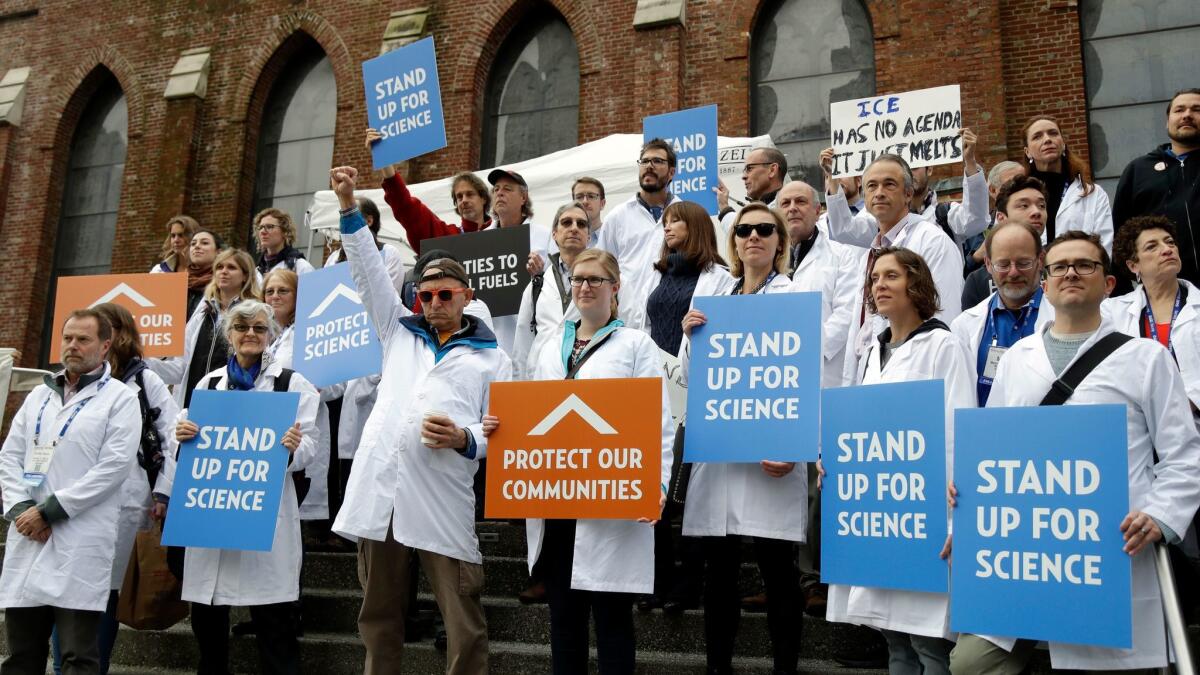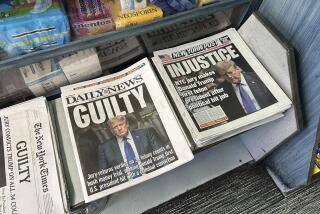Op-Ed: What happens to democracy when the experts can’t be both factual and balanced?

- Share via
Does democracy require journalists and educators to strive for political balance? I’m hardly alone in thinking the answer is “yes.” But it also requires them to present the facts as they understand them — and when it is not possible to be factual and balanced at the same time, democratic institutions risk collapse.
Consider the problem abstractly. Democracy X is dominated by two parties, Y and Z. Party Y is committed to the truth of propositions A, B and C, while Party Z is committed to the falsity of A, B and C. Slowly the evidence mounts: A, B and C look very likely to be false. Observers in the media and experts in the education system begin to see this, but the evidence isn’t quite plain enough for non-experts, especially if those non-experts are aligned with Party Y and already committed to A, B and C.
Both psychological research and commonsense observation of the recent political situation (I think you’ll agree with this, whatever side you’re on) demonstrate the great human capacity to rationalize and justify what you want to believe. The evidence against A can be very substantial — compelling, even, from a neutral point of view — without convincing people who are emotionally invested in the truth of A.
The journalists and educators who live in X now face a dilemma. They can present both sides in a balanced way, or they can call the facts as they see them. Either choice threatens the basic institutions of democracy.
If the cycle continues too long, the end result is destruction of the free press and transformation of the education system into an organ of state propaganda.
If they present balanced cases for and against A, B and C, they give equal time to the false and the true. They create the misleading impression that the matter is still in doubt, that opinion is divided, that it’s equally reasonable to believe either side. They thereby undermine and discredit their own assessment that A, B and C are very likely to be false. This is dangerous, since democracy depends on a well-educated, informed voting public, aware of the relevant facts.
In the long term, journalists and educators will likely turn against balance, because they care intensely about the facts in question and don’t wish to pretend that the evidence is unclear. They understand that they cannot routinely promote false equivalencies while retaining their integrity.
So ultimately they will tell the truth, mostly, as they see it. And this, too, is likely to harm democracy. Since the truth in our example happens to disproportionately favor Party Z over Party Y, and since the members of Party Y are understandably unready to abandon their prior commitments despite the evidence, Party Y will begin to see the media and academia as politically aligned with Party Z. And Party Y will be correct to see things that way. Journalists and scholars will tend to prefer Party Z, because Party Z has got it right about the facts they care about.
Thus begins a vicious cycle: Party Y attacks and undermines academia and the media for perceived bias, pushing the experts further toward Party Z. Members of Party Y become even less willing to listen to expert argument and opinion.
Being human, experts will have their biases. This worsens the cycle. Originally, they might have been more neutral or evenly split between the parties. But now, given their bad treatment by Party Y, they much prefer Party Z — the party that supports, respects and believes them. Party Y’s charges of bias thus find firmer footing: On this point, at least, Party Y is factually correct.
Party Y’s followers react the same way. They believe, partly for good reason, that academia and the media are biased toward Party Z. They begin to perceive Party Y and its allies as the only trustworthy source.
Party Y and its supporters can now appeal to both real and perceived bias to justify suppressing and discrediting educators and the media or even replacing objective scholars and journalists with partisan stooges unmoved by the evidence, worsening and intensifying the cycle.
If the cycle continues too long, the end result is destruction of the free press and transformation of the education system into an organ of state propaganda.
In weak democracies, we’ve seen this cycle repeated over and over again. Aspiring politicians advocating false or mistaken views are called out by academics and the media. Academics and the media thus become their enemies. The battle is fought in the political or military arena, where scholars and journalists rarely have much skill. Public education and freedom of the press can only be saved if Party Z proves stronger.
This is all general and oversimplified. But it’s clear in the abstract and in the real world that knowledgeable people can be forced by the evidence to disproportionately favor one political party over another, creating a vicious cycle of bias and partisan alignment.
We might be entering this cycle in the United States. To fight against it, we must allow journalists, educators and researchers to speak freely. Political leaders and their supporters must not rush to the conclusion that experts who disagree with them — even systematically — are their enemies.
Eric Schwitzgebel is a professor of philosophy at UC Riverside and the author of “Perplexities of Consciousness.” He blogs at The Splintered Mind.
Follow the Opinion section on Twitter @latimesopinion and Facebook
More to Read
A cure for the common opinion
Get thought-provoking perspectives with our weekly newsletter.
You may occasionally receive promotional content from the Los Angeles Times.










